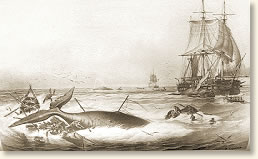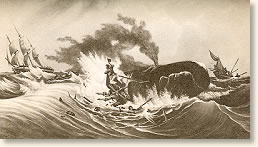|
Aboard a Whaling Ship, 1850
"Thar She Blows!"
In the days before the discovery of petroleum, whale oil supplied the fuel for the lamps that illuminated the nights in American homes. In addition, the whale was the source of a boney substance called baleen used in women's corsets, hairbrushes, buggy whips, collar stays and various other products.
 |
| Whaling in the South Seas |
During the 19th century whaling was a lucrative business and it made many East
Coast seaports rich. Ports such as New Bedford, Massachusetts and Nantucket thrived
as their whaling ships roamed the seas of the world on voyages lasting up to
four
years.
These special-purpose vessels were fast, rugged and versatile. Not only
did they carry the equipment necessary for hunting and killing their prey, but
the technology for processing, storing and preserving their catch until their
return to port. They were the forerunners of today's factory ships
For the whaleman, it was a rough and dangerous life. Once a whale was sighted, the crew took to their whaleboats in pursuit with the immediate objective of harpooning their prey. If the harpooner successfully speared a victim, the whaleboat and its crew were treated to what was called a "Nantucket Sleigh Ride" as the whale dragged its hunters through the sea in an attempt to escape. After two to three hours of this rollercoaster ride, the whale would tire, be finished off and hauled to the mother ship. Here it was cut up and its blubber boiled down to yield its precious oil.
The Reverend Henry T. Cheever was a missionary who roamed the Pacific. In 1850 he was a passenger aboard the Commodore Preble, a whaling ship out of Boston and recorded the experience of a whale hunt:
"For the first time in our now ten weeks' passage from the Hawaiian Islands, on this New Zealand Cruising Ground, we heard, day before yesterday, that life-kindling sound to a weary whaleman, THERE SHE BLOWS! The usual questions and orders from the deck quickly followed.
'Where away?'
'Two points on the weather bow!'
'How far off?'
'A mile and a half!'
'Keep your eye on her!'
'Sing out when we head right!'
It turned out that three whales were descried from aloft in different parts, and in a short time, when we were deemed near enough, the captain gave orders to 'Stand by and lower' for one a little more than half a mile to windward.
Three boats' crews pulled merrily away, glad of something to stir their blood, and with eager hope to obtain the oily material wherewith to fill their ship and make good their 'lay.' The whale was going leisurely to windward, blowing every now and again two or three times, then 'turning tail,' 'up flukes,' and sinking. The boats 'headed' after him, keeping a distance of nearly one quarter of a mile from each other, to scatter (as it is called) their chances.
Fortunately, as the oarsmen were 'hove up,' that is, had their oars a-peak, about the place where they expected the whale would next appear, the huge creature rose hard by the captain's boat, and all the harpooner in the bow had to do was to plunge his two keen cold irons, which are always secured to one tow-line, into the monster's blubber-sides. This he did so well as to hit the 'fish's life' at once, and make him spout blood forthwith. It was the first notice the poor fellow had of the proximity of his powerful captors, and the sudden piercing of the barbed harpoons to his very vitals made him caper and run most furiously.
The boat spun after him with almost the swiftness of a top, now diving through the seas and tossing the spray, and then lying still while the whale sounded; anon in swift motion again when the game rose, for the space of an hour. During this time another boat 'got fast' to him with its harpoons, and the captain's cruel lance had several times struck his vitals. He was killed, as whalemen call it, that is, mortally wounded, an hour before he went into 'his flurry,' and was really dead or turned up on his back.
 |
A Whale's Revenge
A whaleboat attacked by a Sperm Whale |
The loose boat then came to the ship for a hawser to fasten round his flukes; which being done, the captain left his irons in the carcass and pulled for the ship, in order to beat to windward, and, after getting alongside, to 'cut him in.' This done, and the mammoth carcass secured to the ship by a chain round the bitts, they proceeded to reeve the huge blocks that are always made fast for the purpose to the fore and main mast head, and to fasten the cutting-in tackle. The captain and two mates then went over the sides on steps well secured, and having each a breast-rope to steady them and lean upon. The cooper then passed them the long-handled spades, which he was all the time grinding and whetting, and they fell lustily to work chopping off the blubber.
Soon after we had finished cutting in, about eight o'clock in the evening, the wind increased almost to a gale, making it impossible to try out that night. But to-day, while the ship is lying to, the business has begun in good earnest; the blubber-men cutting up in the blubberroom; others pitching it on deck; others forking it over to the side of the 'try-works;' two men standing by a 'horse' with a mincing knife to cleave the pieces into many parts for the more easy trying out, as the rind of a joint of pork is cut by the cook for roasting: the boatsteerers and one of the mates are pitching it into the kettles, feeding the fires with the scraps, and bailing the boiling fluid into copper tanks, from which it is the duty of another to dip into casks.
The whale now taken proves to be a cow whale, forty-five feet long and twenty-five round, and it will yield between seventy and eighty barrels of right whale oil. This is about the ordinary size of the New Zealand whale, a mere dwarf in comparison with that of the northwest, which sometimes yields, it is said, three hundred barrels, ordinarily one hundred and fifty, or one hundred and eighty."
References:
Reverend Cheever's account appears in: Cheever, Henry T., The Whale and His Captors (1853); Stackpole,
Edouard, A., The Sea-Hunters, The New England Whalemen During Two Centuries 1635-1835
(1953).
How To Cite This Article:
"Aboard a Whaling Ship, 1850," EyeWitness to History, www.eyewitnesstohistory.com (2004).
|






